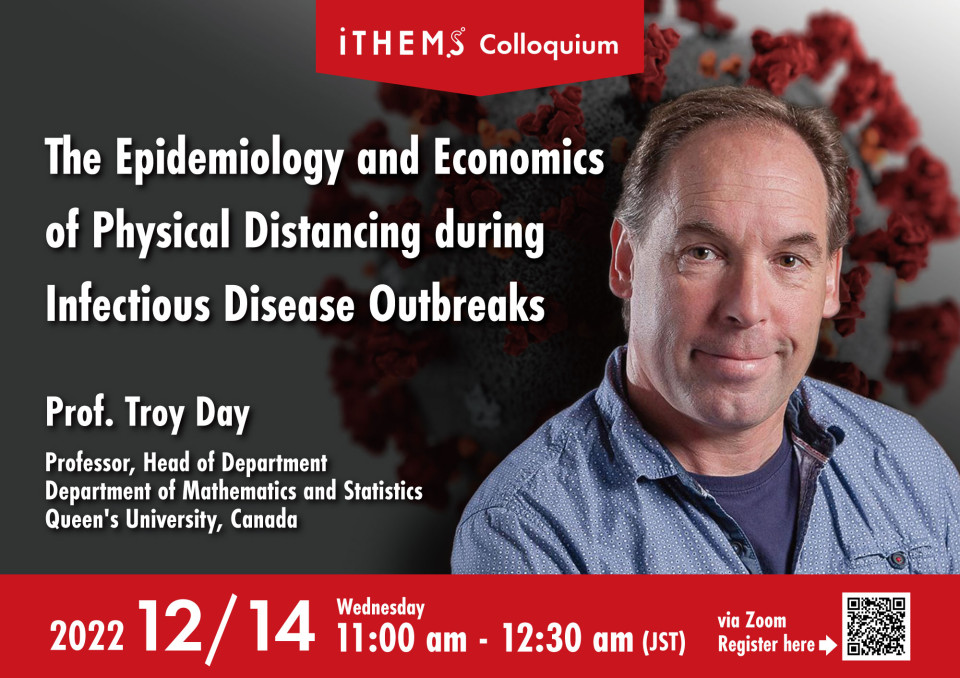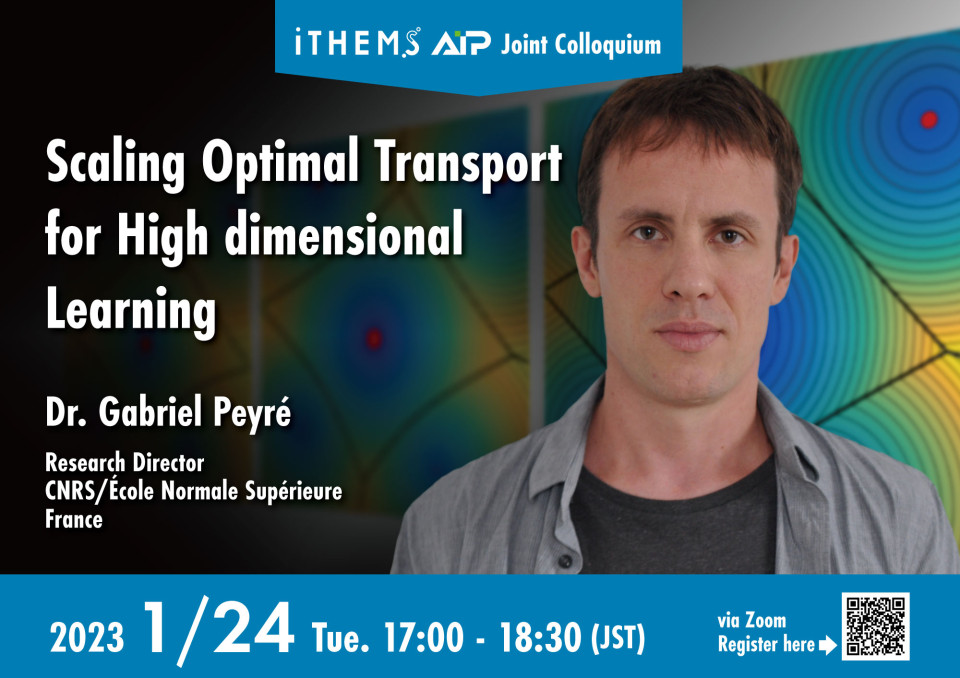Volume 226
Back to Newsletter List
Upcoming Events
Seminar
iTHEMS Biology Seminar
Community assembly and species coexistence in the heterogeneous world
November 28 (Mon) 16:00 - 17:00, 2022
Naoto Shinohara (Assistant Professor, Graduate School of Life Sciences, Tohoku University)
How ecological communities are assembled and maintained is a fundamental question in community ecology. To tackle this challenge in the heterogeneous world, we need to understand how community assembly patterns change with environmental gradients and how species coexist in temporally fluctuating environments. In the first of my talk, I introduce our study on how plant community assembly patterns change along with the largest global environmental gradient, the latitudinal gradient. Then, I will present how the seasonal variability of environments contributes to the coexistence of phytoplankton species in a lake. These results altogether uncover how spatiotemporal heterogeneity of environments forms ecological communities in nature.
Venue: Hybrid Format (Common Room 246-248 and Zoom)
Event Official Language: English
Seminar
NEW WG Seminar
Tricritical phenomena in holographic chiral transitions
November 29 (Tue) 13:30 - 15:00, 2022
Masataka Matsumoto (Postdoctoral Researcher, Department of Physics, Shanghai University, China)
Tricritical point (TCP) is the end-point of a line of three-phase coexistence (a triple line) at which three coexisting phases simultaneously become identical. A TCP can be observed in various systems, for example, the QCD phase diagram with the chiral limit and a metamagnet such as a FeCl2 crystal. In the AdS/CFT correspondence, a TCP associated with a chiral phase transition has been found in the D3/D7 model [1].
In this talk, I will discuss the recent study [2] of critical phenomena at a tricritical point which emerges in the D3/D7 model in the presence of a finite baryon number density and an external magnetic field. We found all the critical exponents defined in this paper take the mean-field values. I will also compare the results with our previous works about the critical phenomena at the TCP that emerges in the steady state [3,4].
References
- Nick Evans, Astrid Gebauer, Keun-Young Kim, Maria Magou, Holographic description of the phase diagram of a chiral symmetry breaking gauge theory, J. High Energ. Phys., volume 2010, Article number: 132 (2010), doi: 10.1007/JHEP03(2010)132, arXiv: 1002.1885
- Masataka Matsumoto, Tricritical phenomena in holographic chiral phase transitions, arXiv: 2208.02605
- Takuya Imaizumi, Masataka Matsumoto, Shin Nakamura, Current Driven Tricritical Point in Large-${N}_{c}$ Gauge Theory, Phys. Rev. Lett. 124, 191603 (2020), doi: 10.1103/PhysRevLett.124.191603, arXiv: 1911.06262
- Masataka Matsumoto, Shin Nakamura, Current-induced inverse symmetry breaking and asymmetric critical phenomena at current-driven tricritical point, Phys. Rev. D 106, 026006 (2022), doi: 10.1103/PhysRevD.106.026006, arXiv: 2201.06894
Venue: Hybrid Format (Common Room 246-248 and Zoom)
Event Official Language: English
Seminar
iTHEMS Seminar
Efficient encoding of the Schrodinger equation on quantum computers
December 5 (Mon) 14:00 - 15:30, 2022
Ermal Rrapaj (Postdoctoral Researcher, RIKEN Interdisciplinary Theoretical and Mathematical Sciences Program (iTHEMS))
The continuous space Schrödinger equation is reformulated in terms of spin Hamiltonians. For the kinetic energy operator, the critical concept facilitating the reduction in model complexity is the idea of position encoding. A binary encoding of position produces a spin-1/2 Heisenberg-like model and yields exponential improvement in space complexity when compared to classical computing. Encoding with a binary reflected Gray code (BRGC), and a Hamming distance 2 Gray code (H2GC) reduces the model complexity down to the XZ and transverse Ising model respectively. Any real potential is mapped to a series of k-local Ising models through the fast Walsh transform. As a first step, the encoded Hamiltonian is simulated for quantum adiabatic evolution. As a second step, the time evolution is discretized, resulting in a quantum circuit with a gate cost that is better than the Quantum Fourier transform. Finally, a simple application on an ion-based quantum computer is provided as proof of concept.
References
- Improving Schrödinger Equation Implementations with Gray Code for Adiabatic Quantum Computers, Chia Cheng Chang, Kenneth S. McElvain, Ermal Rrapaj, and Yantao Wu, PRX Quantum 3, 020356, doi: 10.1103/PRXQuantum.3.020356
- Ermal Rrapaj, Kenneth S. McElvain, Chia Cheng Chang, Yantao Wu, André Walker-Loud, Gate Based Implementation of the Laplacian with BRGC Code for Universal Quantum Computers, doi: 10.48550/arXiv.2207.11647
Venue: Common Room #246-248, 2F Main Research Building, RIKEN / via Zoom
Event Official Language: English
Seminar
iTHEMS Seminar
Carrollian hydrodynamics near the black hole horizon
December 8 (Thu) 16:00 - 17:30, 2022
Puttarak Jai-akson (Postdoctoral Researcher, RIKEN Interdisciplinary Theoretical and Mathematical Sciences Program (iTHEMS))
The membrane paradigm provides a fascinating bridge between gravitational dynamics near black hole horizons (null boundaries) and fluid dynamics. One question naturally follows: what type of fluids and hydrodynamics emerged at the horizon? Contrary to the longstanding belief, it turns out that the horizon fluid is Carrollian, rather than the Galilean (Navier-Stokes) fluid. The Carroll geometries and Carrollian physics, arising originally when the speed of light goes to zero (c to 0 limit), have recently gained increasing attention in the fields of black hole physics and flat holography.
In this presentation, I will talk about the Carrollian limit and the resulting Carroll geometries and this unusual kind of hydrodynamics, the Carrollian hydrodynamics. I will then present the geometrical construction of the membrane (also known as the stretched horizon) in a way that a Carroll geometry manifest, therefore allowing us to spell out precisely the dictionary between gravitational degrees of freedom on the membrane and the Carrollian fluid quantities. I will also show that the Einstein’s equations projected onto the horizon are the Carrollian hydrodynamic conservation laws. Lastly, I will discuss the covariant phase space of the horizon, symmetries, and conservation laws. The talk is based on arXiv:2209.03328 and arXiv:2211.06415.
References
- Laurent Freidel, Puttarak Jai-akson, Carrollian hydrodynamics from symmetries, arXiv: 2209.03328
- Laurent Freidel, Puttarak Jai-akson, Carrollian hydrodynamics and symplectic structure on stretched horizons, arXiv: 2211.06415
Venue: Hybrid Format (Common Room 246-248 and Zoom)
Event Official Language: English
Seminar
iTHEMS Theoretical Physics Seminar
Chiral effects on lepton transport in core-collapse supernovae
December 13 (Tue) 13:30 - 15:00, 2022
Di-Lun Yang (Assistant Research Fellow, Institute of Physics, Academia Sinica, Taiwan)
Dynamics of leptons such as electrons and neutrinos play an important role in the evolution of core-collapse supernovae (CCSN). Nevertheless, chirality as one of fundamental microscopic properties that could affect lepton transport, through e.g. weak interaction, has been mostly overlooked. In this talk, I will discuss how chiral effects such as the renowned chiral magnetic effect (CME), generating an electric charge current along magnetic fields with chirality imbalance, could result in the unstable modes of magnetic fields and inverse cascade, which potentially influence the matter evolution in CCSN and pulsar kicks. I will also show how an effective CME could be realized via the backreaction from neutrino radiation even in the absence of an axial charge characterizing an unequal number of right- and left-handed electrons.
Venue: Hybrid Format (Common Room 246-248 and Zoom)
Event Official Language: English
Colloquium
iTHEMS Colloquium
The Epidemiology and Economics of Physical Distancing during Infectious Disease Outbreaks
December 14 (Wed) 11:00 - 12:30, 2022
Troy Day (Professor, Head of Department, Department of Mathematics and Statistics, Queen's University, Canada)
People's incentives during an infectious disease outbreak influence their behaviour, and this behaviour can impact how the outbreak unfolds. Early on during an outbreak, people are at little personal risk of infection and hence may be unwilling to change their lifestyle to slow the spread of disease. As the number of cases grows, however, people may then voluntarily take extreme measures to limit their exposure. Political leaders also respond to the welfare and changing desires of their constituents, through public health policies that themselves shape the course of the epidemic and its ultimate health and economic repercussions. In this talk I will use ideas from the study of differential games to model how individuals’ and politicians’ incentives change during an outbreak, and the epidemiological and economic consequences that ensue when these incentives are acted upon. Motivated by the COVID-19 pandemic, I focus on physical distancing behaviour and the imposition of stay-at-home orders by politicians. I show that there is a fundamental difference in the political, economic, and health consequences of an infectious disease outbreak depending on the degree of asymptomatic transmission. If transmission occurs primarily by asymptomatic carriers, then politicians will be incentivized to impose stay-at-home orders earlier and for longer than individuals would like. Despite such orders being unpopular, however, they ultimately benefit all individuals. On the other hand, if the disease is transmitted primarily by symptomatic infections, then individuals are incentivized to stay at home earlier and for longer than politicians would like. In this case, politicians will be incentivized to impose back-to-work orders that, despite being unpopular, will again ultimately be to the benefit of all individuals.
This is joint work with David McAdams, Fuqua School of Business and Economics Department, Duke University.
Venue: via Zoom
Event Official Language: English
Seminar
iTHEMS Seminar
Lattice gauge theory in curved spacetimes
December 15 (Thu) 14:00 - 15:30, 2022
Arata Yamamoto (Assistant Professor, Department of Physics, Graduate School of Science, The University of Tokyo)
Lattice gauge theory is a powerful computational approach in quantum field theory. It is also utilizable for investigating quantum phenomena in curved spacetimes, such as rotating frame, torsion, and gravitational backgrounds. In this talk, I would like to overview the formulation and results of lattice simulations in curved spacetimes.
References
- A. Yamamoto and Y. Hirono, Lattice QCD in Rotating Frames, Phys. Rev. Lett. 111, 081601 (2013), doi: 10.1103/PhysRevLett.111.081601
- A. Yamamoto, Lattice QCD in curved spacetimes, Phys. Rev. D 90, 054510 (2014), doi: 10.1103/PhysRevD.90.054510
- S. Benic and A. Yamamoto, Quantum Monte Carlo simulation with a black hole, Phys. Rev. D 93, 094505 (2016), doi: 10.1103/PhysRevD.93.094505
- S. Imaki and A. Yamamoto, Lattice field theory with torsion, Phys. Rev. D 100, 054509 (2019), doi: 10.1103/PhysRevD.100.054509
Venue: Common Room #246-248, 2F Main Research Building, RIKEN / via Zoom
Event Official Language: English
Seminar
ABBL-iTHEMS Joint Astro Seminar
Understanding kilonova spectra and identification of r-process elements
January 20 (Fri) 14:00 - 15:00, 2023
Nanae Domoto (Ph.D. Student, Department of Astronomy, Graduate School of Science, Tohoku University)
Binary neutron star (NS) merger is a promising site for the rapid neutron capture nucleosynthesis (r-process). The radioactive decay of newly synthesized elements powers electromagnetic radiation, as called kilonova. The detection of gravitational wave from a NS merger GW170817 and the observation of the associated kilonova AT2017gfo have provided with us the evidence that r-process happens in the NS merger. However, the abundance pattern synthesized in this event, which is important to understand the origin of the r-process elements, is not yet clear. In this talk, I will first introduce an overview and current understanding of kilonova. Then, I will discuss our recent findings of elemental features in photospheric spectra of kilonova toward identification of elements.
Venue: via Zoom
Event Official Language: English
Colloquium
iTHEMS Colloquium
Scaling Optimal Transport for High dimensional Learning
January 24 (Tue) 17:00 - 18:30, 2023
Gabriel Peyré (Research Director, CNRS/École Normale Supérieure, France)
iTHEMS-AIP Joint Colloquium
Optimal transport (OT) has recently gained a lot of interest in machine learning. It is a natural tool to compare in a geometrically faithful way probability distributions. It finds applications in both supervised learning (using geometric loss functions) and unsupervised learning (to perform generative model fitting). OT is however plagued by the curse of dimensionality, since it might require a number of samples which grows exponentially with the dimension. In this talk, I will explain how to leverage entropic regularization methods to define computationally efficient loss functions, approximating OT with a better sample complexity. More information and references can be found on the website of our book "Computational Optimal Transport" (see related link below).
Venue: via Zoom
Event Official Language: English
Upcoming Visitor
November 28 (Mon) - December 2 (Fri) 2022 Masataka MatsumotoPostdoctoral Researcher, Department of Physics, Shanghai University, China Visiting Place: RIKEN Wako Campus |
Paper of the Week
Week 4, November 2022
2022-11-24
Title: Index theory of chiral unitaries and split-step quantum walks
Author: Chris Bourne
arXiv: http://arxiv.org/abs/2211.10601v1
Title: Emergent higher-form symmetry in Higgs phases with superfluidity
Author: Yoshimasa Hidaka, Dan Kondo
arXiv: http://arxiv.org/abs/2210.11492v1
Title: Entanglement Generation and Decoherence in a Two-Qubit System Mediated by Relativistic Quantum Field
Author: Yoshimasa Hidaka, Satoshi Iso, Kengo Shimada
arXiv: http://arxiv.org/abs/2211.09441v1
Title: Quantum Metrology Protected by Hilbert Space Fragmentation
Author: Atsuki Yoshinaga, Yuichiro Matsuzaki, Ryusuke Hamazaki
arXiv: http://arxiv.org/abs/2211.09567v1
If you would like to cancel your subscription or change your email address,
please let us know via our contact form.
Copyright © iTHEMS, RIKEN. All rights reserved.






